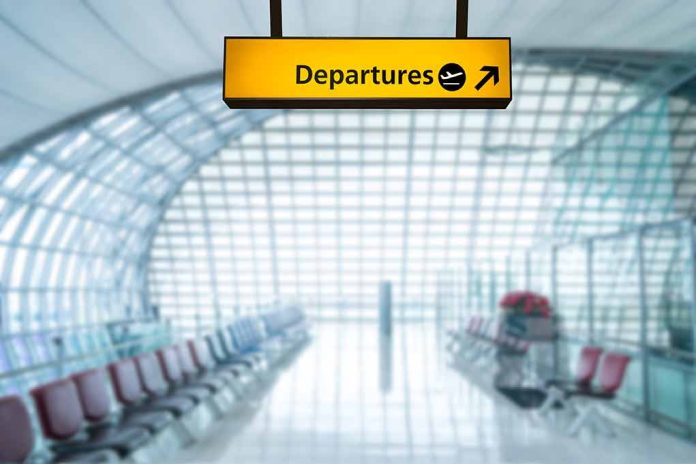
Newark Liberty International Airport is facing an unprecedented crisis as staffing shortages and runway repairs force hundreds of flight cancellations and delays of up to five hours, leaving thousands of travelers stranded and unsure when normal operations will resume.
Key Takeaways
- Newark Airport has experienced severe operational disruptions with arriving flights delayed by an average of 381 minutes and nearly 20% of flights canceled.
- The crisis stems from a combination of air traffic controller staffing shortages (the FAA is short approximately 3,500 controllers nationwide) and a $121 million runway rehabilitation project scheduled to continue until mid-June 2025.
- Air traffic control management has been temporarily rerouted to Philadelphia, where equipment malfunctions have further compounded the problem.
- Transportation Secretary Sean Duffy has acknowledged “cracks in the system” and announced plans to offer bonuses to retain controllers and expedite hiring processes.
- Airlines are not offering hotel accommodations to stranded passengers, citing the delays as an FAA issue rather than airline responsibility.
Crisis Escalates as Delays Reach Five Hours
Newark Liberty International Airport has descended into operational chaos as a perfect storm of staffing shortages, equipment failures, and construction has created unprecedented delays. Arriving flights have been delayed by an average of five hours, with the Federal Aviation Administration implementing ground stops and flow control measures. One day alone, nearly 20% of flights were canceled and over 40% were delayed, stranding thousands of travelers with little recourse as airlines denied hotel accommodations, citing the problems as FAA-related issues outside their control.
The situation has deteriorated rapidly as air traffic control faces a triple threat: a nationwide controller shortage of approximately 3,500 staff, equipment failures at the Philadelphia control center that now manages Newark airspace, and reduced runway capacity. With over 400 flights delayed and more than 200 canceled in a single day, the ripple effects have cascaded throughout the national air transportation system, particularly affecting United Airlines, which uses Newark as a major hub.
A shortage of air traffic controllers is causing problems at Newark Airport near New York City, which could see more flight delays as the busy summer travel season approaches. @trevorlault reports. pic.twitter.com/lcou9HsAOa
— Good Morning America (@GMA) May 2, 2025
Runway Construction Compounds Staffing Crisis
A significant $121 million runway rehabilitation project has reduced Newark to a single runway for takeoffs and landings during certain periods, severely limiting operational capacity. According to airport officials, one runway will remain fully closed until mid-June 2025, creating a long-term constraint on airport operations. This construction timeline overlaps with peak travel seasons, raising concerns about how the airport will manage summer travel demands when passenger volumes traditionally surge.
The reduced capacity comes at a particularly challenging time as the FAA has extended minimum flight requirements at New York City-area airports through October 2025 specifically because of the ongoing staffing shortages. These requirements, designed to prevent airlines from scheduling more flights than the system can handle, highlight the long-term nature of the air traffic control crisis facing the region.
Transportation Secretary Acknowledges “Cracks in the System”
Transportation Secretary Sean Duffy has publicly acknowledged the severity of the situation, describing it as revealing “cracks in the system” that require immediate attention. His comments underscore the seriousness of the infrastructure and staffing challenges facing U.S. aviation. The Department of Transportation has announced several measures aimed at addressing these critical shortages, including bonuses to encourage controllers to delay retirement, relocating controllers to understaffed facilities, and implementing pay raises for new controllers.
Duffy has set an ambitious timeline for addressing the controller shortage, stating, “We’re hoping in three to four years we can get to full staffing, not 20 years.” The plan includes widening the training pipeline for new controllers and revamping air traffic control infrastructure and equipment. Current controllers are working mandatory overtime and six-day weeks to compensate for the staffing deficit, raising concerns about fatigue and its potential impact on safety.
Travelers Face Prolonged Uncertainty
As the crisis continues with no immediate resolution in sight, travelers are advised to double-check flight status before heading to the airport and to prepare for possible disruptions. The convergence of staffing shortages, equipment problems, and construction creates a particularly challenging environment that will likely persist for months. With summer travel season approaching, industry experts warn that without significant intervention, the situation at Newark could deteriorate further as passenger volumes increase.
For residents of the greater New York metropolitan area, Newark’s operational difficulties present a significant blow to transportation reliability. With the construction project scheduled to continue through mid-2025 and controller staffing issues requiring years to resolve, travelers may need to adjust expectations and build additional flexibility into their travel plans for the foreseeable future.
Sources:
Newark airport experiencing cancellations, delays once again due to staffing, construction issues
FAA staffing issues, runway repairs force hundreds of flight cancellations, delays at Newark airport







